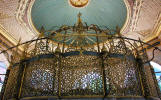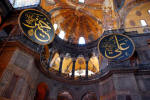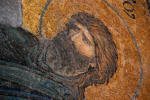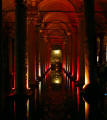|
|
|
|
BLUE MOSQUE, HAGIA SOPHIA & BASILICA CISTERN - ISTANBUL |
|
The Blue Mosque We had been admiring the magnificence of the Blue Mosque with its six minarets and great cascade of domes seen towering above Sutanahmet Square.
|
||||
|
Each night the mosque would be lit up with a flashing, ever changing colored narrated light show. |
|
|
We entered the courtyard of the Blue Mosque where some ablution fountains are located. These ablution fountains are for people who are getting prepared to pray in the mosque. The requirement is to wash face, arms, neck and feet as well as mouth and nose. There are beautiful tiered marble steps leading to the main courtyard, the marble comes from the Island of Marmara. |
|
|
|
|
Inside the breathtaking interior of the mosque is lit by numerous chandeliers. The walls are covered with 17C blue Iznik tiles which give the Blue Mosque its name. The floors are carpeted with prayer rugs, full of people praying on their knees. |
|
|
|
|
Istanbul's Blue Mosque was built partly as an effort to show Christians that Ottoman culture could produce something to rival the Haghia Sophia. Some believed that a mosque with 6 minarets was a sacrilegious attempt to rival the architecture of Mecca itself. The dome rises to about 140 feet high and is 77 feet in diameter. Four colossal standing columns hold up the roof; they measure about 16 feet in diameter. 260 windows, many stained glass, let the sunlight diffuse into the building. From the second floor the view of the architectural magnitude was astounding. The gigantic iron chandelier hanging from the ceiling was so huge, you could barely see the local Muslims praying below. |
|
||
|
|
|
|
|
|





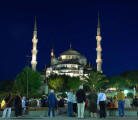












 Haghia
Sophia
Haghia
Sophia





